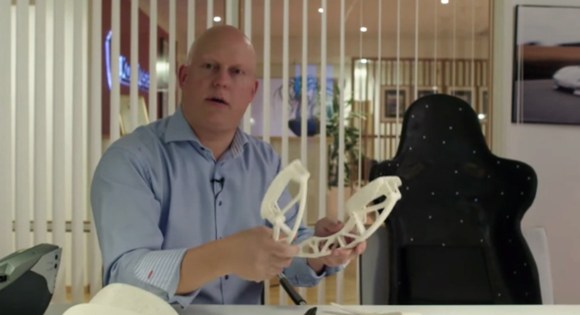
We’re not surprised to see a car manufacturer using 3D-printing technology, but we think this may be the first time we’ve heard of 3D-prints going into production vehicles. You’ve likely heard of Christian von Koenigsegg’s cars if you’re a fan of BBC’s Top Gear, where the hypercar screams its way into the leading lap times.
Now it seems the Swedish car manufacturer has integrated 3D printing and scanning into the design process. Christian himself explains the benefits of both for iterative design: they roughed out a chair, adjusting it as they went until it was about the right shape and was comfortable. They then used a laser scanner to bring it into a CAD file, which significantly accelerated the production process. He’s also got some examples of brake pedals printed from ABS—they normally machine them out of aluminum—to test the fits and the feeling. They make adjustments as necessary to the prints, sometimes carving them up by hand, then break out the laser scanner again to capture any modifications, bring it back to CAD, and reprint the model.
Interestingly, they’ve been printing some bits and pieces for production cars out of ABS for a few years. Considering the low volume they are working with, it makes sense. Videos and more info after the jump.
The first video shows a Dimension 1200es—a $30k printer—toiling away in the background, presumably cranking out some of their ABS test pieces. A second video describes another 3D-printed build, this time with metal, to construct a 2-phase turbocharger. The custom turbo has two chambers that twist around each other, with flexible walls that bend to optimize flow. Koenigsegg claims that they could have cast it with a lot of trial and error, but that 3D-printing the complex shapes was simply faster and easier. They’re printing the moving parts in place internally so they don’t have to assemble it. Even the threads to mount the turbo are printed, so a near-finished turbocharger rolls out of the printer ready to bolt on.
[Thanks Matt]















Bugatti’s been doing it for more than 5 years now: http://www.shapeways.com/blog/archives/164-the-bugatti-veyrons-3d-printed-dashboard.html
ah, very cool. I guess it’s a perfect storm for innovation for these low volume production models. can take bigger risks, etc.
KoenigseggisseggggnignigsegigisegggnigseggniggseggCCX with the Top Gear win
g
“Even the threads to mount the turbo are printed, so a near-finished turbocharger rolls out of the printer ready to bolt on.”
At what resolution. No 3d metal printer commercially available can print proper threads. The layer thickness is too high and the resolution and surface finish too poor. Sure they “thread on”. Sort of.
So we could believe you, or we could believe the guys that have built the car…tough choice.
http://3.bp.blogspot.com/_gK7WmTtYN20/S782HwmG4bI/AAAAAAAAABg/uBFXQl51FBo/s1600/0286+-+20100120_060641.bmp
The shell behind the finished part is a “raw” part.
Sadly, waterjet guy is probably correct. Fabbing metal parts like screws, fasteners and threads using print/sinter/whatever technology is amazing in terms of flexibility, but no match whatsoever for proper CNC via a screw machine or similar subtractive process.
You could print a part and them machine it before or after plating, but for most fasteners making more than a few would mean that a screw machine is a better investment. So far, it’s generally a rule that additive process manufacturing is on par with cheap casting.
Other people are correct – you could make a working fastener combo from printing, but it’ll be a bit before they have it down. On the other hand… it’s not really much worse than the lowest priced hardware coming from chinese factories. There are valid applications for this.
“No 3d metal printer commercially available can print proper threads.”
Ahh, but surely they also print the screws to match said imperfect threads!
No Loctite required! LMAO! If great (coarse) thread depth was used, and threads, chased w a tap, more is possible, yes. A flexible scroll?!? Wow.
Any standard 3D printer worth its salt can print a not and a bolt that meshes together :)
“Meshes together”, sure. But meshes well? Not really.
There’s a whole series of videos from Koenigseggisseggggnignigsegigisegggnigseggniggsegg on the /Drive channel, a very interesting watch: https://www.youtube.com/playlist?list=PLHa6PXrV-yIgnXSYFT07BouKhEhyFuWnf
fucking amazing set of cars … they posted a video not too long ago showing how they hand make the world’s only totally carbon fiber wheel hubs
Don’t know if they’re TOTALLY carbon fiber, but there’s at least 2 companies apparently making carbon fiber wheels for other vehicles with a quick google search for “carbon fiber wheel” and a few other one offs of hand laid carbon fiber wheels. Not to reduce the significance of what koennigsegg has done (they’re my favorite car after all), but it’s exciting that one could potentially get those wheels for almost any vehicle they want.
two of my favorite websites. DRIVE and Hackday
http://www.engineering.com/3DPrinting/3DPrintingArticles/ArticleID/6265/3D-Printing-of-Titanium-Aluminide-Turbochargers-A-Turbocharge-For-Arcam-AB-Earnings.aspx
I supose you guys are not on par about what real high end metal sintering printers can do, right?
http://s11.postimg.org/tjx9rfq6b/fos_kc11.jpg
http://s11.postimg.org/da73ojfib/FOS_cylinder_5.jpg
Nope, those don’t exist. I know this because of what someone anonymously wrote in a comments section.
No, the bodies are certainly doable – you just have to add traditionally machined bearings and parts…. and probably machine the “casting” a little. Printing resolution can certainly match sand castings.
They can display a rendering and print a metal part with poor surface finish?
I just realized this guy looks like the mask in the movie drive http://unfilmde.files.wordpress.com/2012/04/drive3.jpg
The uses for 3D printers keep getting more innovative – and sometimes a little scary. It seems manufacturing will be a lot different in the next decade.